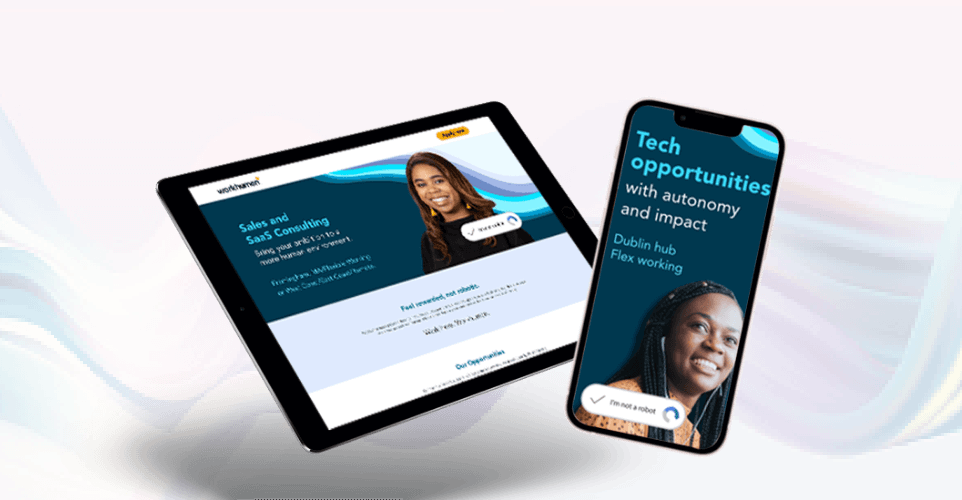Marketing and employer branding are becoming intrinsically linked; if you’ve read any of our previous blogs, you’ll know this. The days of the employer brand being the sole responsibility of talent and HR teams are a thing of the past. Employer branding is evolving. To be successful in improving talent acquisition and retention strategies, it needs to run throughout the entire business.
Employer branding is a term to describe induvial perceptions of you as an employer both internally from existing teams and externally to future candidates. These perceptions are built on experiences and interactions with your brand, whether that’s the application process, workplace reviews or the social media posts you put into the world. This means that every aspect of the business, whether they know it or not, plays a part in building your employer brand and painting a picture of what it’s like to work there.
Your employer and consumer brands are not the same, and they don’t always match up. Think of a hotel that promotes relaxation and luxury to guests, their employees can’t relax, or this experience wouldn’t happen. However, your employer brand can severely affect your consumer, which we all learned during the pandemic. Mistreatment of employees and negative employer brand perceptions can also be incredibly damaging to consumer brands. Similarly, positive perceptions can enhance your consumer brand. The two may not be linked, but they can directly impact each other, which is why employer branding is now more marketing’s business than ever.
Plus, to help your employer branding gain the reach it needs in today’s competitive talent market, raising awareness must be part of your recruitment marketing strategy. Businesses need to communicate messaging, which will influence how they’re viewed as employers on the same platforms that marketing uses daily, from social media to blogs. As tech recruitment becomes more competitive, recruiters need to act more like marketers by selling the employer brand, and marketers need to act more like recruiters by focusing on the workplace as well as the product on offer.
As employer branding and marketing become more synonymous with each other, talent teams need to ensure marketing teams are up to speed on how to promote their workplace to candidates. Therefore, we’re looking at what CMOs and marketers need to know about employer branding.
Employer Branding should be specific
Marketing is usually about getting as many people to become aware of your product or service as you can. Employer brand and recruitment marketing is the opposite. You may think that the world of recruitment means attracting as many people as possible and getting as many applications as you can. This isn’t strictly true. When it comes to employer branding, the more specific you are, the better in the current market. Think quality over quantity. Not every business is the same, and not all candidates will thrive in your company culture. You want to find candidates who perfectly fit your culture, who will thrive with you and who have the desired skills to enhance your organisation: the wider your reach, the more work for talent teams.
Your employer brand communications should be more about searching for a better quality candidate, even if this means reaching a small, perfectly tailored audience. After all, not everyone will have the skills to be a C++ developer. Targeting individuals with specific skillsets or tailoring your messaging to resonate with particular talent may be the opposite of what marketers are used to, but it will help to ensure a better quality of hire.
When it comes to messaging, your employer brand communications need to create an authentic picture of what it’s like to work there. You need to celebrate your company culture accurately, with perhaps a bit of realistic aspiration. This realistic messaging will help your employer brand communications to resonate with the right candidates, those with a similar mindset and attitude.
Recruitment marketing isn’t only for LinkedIn
CMOS and marketing teams may believe that recruitment marketing starts and ends with LinkedIn. Of course, LinkedIn is an excellent platform for recruitment. It’s a place to advertise jobs and to connect with candidates. However, connecting with those actively seeking a job isn’t always enough in the current recruitment market.
We’re in a candidate-driven market, where the number of open vacancies significantly outweighs the number of qualified candidates looking for opportunities. Therefore, for recruitment success, employer brand messaging and recruitment marketing must also reach passive candidates—those talented individuals who aren’t actively looking for a new opportunity.
To reach these individuals, more consumer-based digital marketing platforms could be key. LinkedIn is great, but many people don’t use it until they’re looking for a new role. So, if the aim is to raise employer brand awareness, it might be worth using the platforms where these candidates spend the most time, like Facebook, Instagram and TikTok or using Google’s Display Network. This way, you can capture the attention of those who aren’t actively looking and hopefully inspire them to learn more about your workplace and available opportunities.
Employer brand is the human side to your corporate brand
Social media is popular because it’s made celebrities accessible and given us an insight into what goes on behind the scenes and who they are as people. It’s proven that as humans, we like to connect with people and see the human side of individuals and businesses. Corporate brands can do the same. Think of your employer brand communications as giving a human-centric aspect to your consumer brand. People want to know the stories of the individuals behind a business, gain an idea of what the company culture is like behind the scenes, and feel personally connected to a business. This will help build a talent pool of engaged talent who want to work with you and feel excited about your mission.
Promoting your employer brand gives employees a voice and allows them to share experiences and stories. In a world where we’ve been separated from people for almost two years, human connection and humanising brands is hugely crucial whether in recruitment or corporate marketing. Putting faces to your employer brand communication strategy will help it appear authentic and will show you care about the opinions and experiences of your people.
Employer brand is constantly evolving
Your employer brand is not one thing. It’s a term used to define perceptions. Therefore, it’s constantly changing and evolving. The idea that your employer brand is static will only leave your talent acquisition strategies in the past. If the last few years have shown us anything, it’s that recruiters in scaling businesses need to constantly adapt their messaging to relate to changing candidate priorities and to help them retain their best players. This is the only way a workplace can remain relevant and exciting.
As the organisation grows, you’ll have more employee stories to tell and more significant aspects of your culture to celebrate. Every part of the business impacts the Employer Brand and helps it to maintain a state of flux. Therefore, marketing needs to stay up to date with the goings-on in the business, learning of any changes in culture. This is the only way to ensure employer brand messaging and communication matches changing perceptions and that the company can attract the talent it needs to scale.
Just like a business needs marketing to promote a product or service, a workplace needs an employer brand communication strategy and recruitment marketing to attract employees. If marketing and HR can work together, these strategies will be more innovative, creative and data-driven. This means CMOs need to understand what an employer brand is and how significant it is to talent acquisition strategies.
If you’d like help building an employer brand communication strategy, Talent Works can help. For scaling tech businesses, leveraging employer brand perceptions could be vital to attracting and retaining talent in the future.
To find out more, contact us.








